
Installation Guide
(888) 788-2254
CaliFloors.com
cork

Questions? (888) 788-2254
CaliFloors.com
CALI Cork Flooring Installation Guide
The Collection
Flooring Systems
Wide+ Click
11-5/8” Wide
Plank Dims:
35-5/8” x 11-5/8” x 7/16”
Flooring Accessories
Threshold
Reducer
Stair Tread
Quarter Round
Stair Nosing - Overlap
T-Molding

Questions? (888) 788-2254
CaliFloors.com
CALI Cork Flooring Installation Guide
Before you begin installation, remember to P.A.C.E. yourself with the checklist below. Full installation
instructions and maintenance guidelines can also be found online at CaliFloors.com
Pre-Installation
P ACE
EXPANSION
GAPS
Cork flooring can be used in areas ranging from
35% to 65% relative humidity.
Leave at least 3/8” expansion spaces between flooring and ALL
vertical objects (walls, cabinets, pipes, etc.) Large flooring runs
may require additional expansion space. Use transition
moldings between rooms and doorways. Undercut door
jambs and casings to provide adequate expansion space. Do
not screw or nail cabinetry or other permanent fixtures to a
floating floor.
3/8” Expansion Gap
3/8” Spacer
Baseboard
PA C E
CONTROL
ENVIRONMENT
Make sure the subfloor is flat, level, clean and free of
debris. New concrete must be cured for at least 60 days.
Test the subfloor moisture prior to installation and apply
an appropriate moisture barrier such as 6mil Plastic on
concrete subfloors or Silicon Vapor Shield on plywood.
Use 6mil Plastic on Concrete
PA CE
ACCLIMATE
FLOORING
Prior to installation, store planks at room temperature,
unopened and in their original packaging. Acclimate
the boxes of flooring as close to the installation area
as possible, for 48 hours in normal living conditions.
Acclimate Your Cork Flooring For 2 to 3 Days
PACE
PREPARE
THE SUBFLOOR
35-65% rH

Questions? (888) 788-2254
CaliFloors.com
CALI Cork Flooring Installation Guide
Pre-Installation
Prepare Job Site, Acclimation, Control Subfloor Moisture, Environmental Conditions
Proper installation and maintenance are key elements in achieving best flooring results. It is the responsibility
of the installer/owner to follow all guidelines provided by CALI for success. Please read through this document
completely, additional installation materials such as videos, illustrations and more can also be found at
CaliFloors.com.
Important Pre-Installation Notes
Note: Flooring not used for its intended purpose will not be covered under warranty.
The following information provided by CALI is intended to serve as a reference guide only. Please carefully read
CALI’s installation, maintenance and warranty documentation prior to installation. Follow the National Wood Flooring
Association (NWFA) Installation Guidelines when installing your floor.
• Upon ordering Cork floor materials, consider adding an additional 5% to allow for cutting waste and grading
allowance.
• CALI® flooring is manufactured in accordance with accepted industry standards, which permit manufacturing,
grading and natural deficiencies not to exceed 5%. If more than 5% of the material is unusable, do not install the
flooring. Immediately contact the distributor/retailer from which the flooring was purchased. No claim will be
accepted for materials with visible defects once they are installed. Installation of any material serves as acceptance
of the material delivered.
• Installer/Owner assumes all responsibility to inspect all flooring before installation. Planks deemed unacceptable in
appearance can be placed in closets, near walls or simply not be used. Pieces with glaring defects that can be seen
from a standing position should be cut off or not be used as use constitutes acceptance.
• It is the responsibility of the installer/homeowner to determine if the jobsite conditions, environmental conditions
and sub-floor are acceptable for the installation of CALI® Cork flooring. Prior to installation, the installer/owner
must determine that the jobsite meets or exceeds all applicable National Wood Flooring Association Installation
Guidelines. CALI does NOT warrant against failure resulting from or connected with the subfloor, job site damage,
or environmental deficiencies after installation.
• CALI makes no warranty or guarantee of the quality of the chosen installer’s work or of a particular installation
performed by him or her. CALI disclaims all liability for any errors or improprieties in the installation of its products
by an installer.
• Floor noise is normal and will vary from one installation type to the next. Occasional noise is due to structural
movement and may relate to sub-floor type, flatness, deflection, changes in environmental conditions, relative
humidity and/or the amount of topside pressure applied to the flooring. For these reasons floor noise is not
considered a product or manufacturer defect.
• Prior to installation, it is the installer’s responsibility to document all jobsite conditions and measurements including
the installation date, site relative humidity, temperature, and subfloor moisture content. This information must be
retained by the installer and left with the property owner as a permanent record. For a complete list of points to
address prior to installation, refer to the NWFA Jobsite checklist.
• Do not install flooring under permanent or fixed cabinetry.
• Never nail or screw anything through a FLOATED floor.
• Cork Floating floors are intended for indoor use only.
Important Pre-Installation Notes
• Transport and store cartons in lay down, flat position.
• Stack boxes no more than 6 cartons high. Keep away from direct sunlight.
• Allow flooring to acclimate, unopened, in original packaging as close to the installation area as possible for at least
48-72 hours prior to installation.
• Room temperature must be at least (65ºF) before and during installation. Relative humidity should be maintained
between 35% – 65% for optimal performance.
Control Home Conditions Accordingly – Acclimation should occur at normal living conditions. Before opening the
cartons, the indoor environment should reflect the room temperature and relative humidity levels expected to be
present before, during, and most importantly, after installation. Operate temperature / humidity control systems as
normal. Allow normal ventilation through rooms.
Room temperature and relative humidity must be consistent with year - round living conditions for at least 5 days
prior to installation.

Questions? (888) 788-2254
CaliFloors.com
CALI Cork Flooring Installation Guide
Pre-Installation
Prior to Installation of CALI Flooring
Job Site Preparation
Prior to installation, inspect planks in daylight for visible faults/damage. Check if subfloor/site conditions comply with the
specifications described in these instructions. If you are not satisfied do not install, and contact your supplier. CALI is not
responsible for flooring that is installed with visible defects.
Before laying: Measure the room at a right angle to the direction of the planks. Planks in the final row should be at least
1/3 the width of a plank. Due to this rule, planks in the first row can be cut to smaller size. Shuffle planks in order to obtain
a pleasant blend of shades. Lay planks preferably following the direction of the main source of light. Over wood subfloors,
we recommend laying the planks crossways to the existing joists. Planks must not be nailed or screwed to the subfloor.
Skirting boards must not be fixed in a way which restricts the movement of the floor.
Expansion gaps: Since cork can expand with any increase in moisture content, we require leaving at least 3/8” expansion
space between flooring and all vertical objects (walls, cabinets, pipes, etc.). If the installation area exceeds 30 feet, a
greater expansion space is required; approximately 1/16” for every additional ten (10) feet. If the floating installation flows
into other rooms, a T-molding must be used in doorways and openings between rooms (halls, archways, etc.) to allow
separate areas to move without interference. We consider a doorway or opening any area that is 3 feet in width or less.
• Note that proper expansion space depends not only on the size and flow of the installation, but also on expected
seasonal changes in temperature and humidity that may cause the flooring to gain or lose moisture content over
time. For example, if an installation takes place when humidity conditions are low, it’s likely that the cork flooring
will gain moisture and expand later during humid seasons. In those cases, incorporate additional expansion space
through use of spacers or transition moldings.
• If the installation area exceeds 30 feet, a greater expansion space is required; approximately 1/16” for every additional
ten (10) feet. If the floating installation flows into other rooms, a T-molding must be used in doorways and openings
between rooms (halls, archways, etc.) to allow separate areas to move without interference.
• Cork floors must be able to expand/contract without interference. NEVER install flooring against any vertical or fixed
object such as fireplace, columns, islands, door jambs, floor outlets, etc. Failure to follow this guideline may result in
tenting, separation or buckled floors. Do not install cabinets or other permanent fixtures on top of the floor. Never nail
or screw anything through a FLOATED floor. It is never recommended to put objects or furniture weighing over 500
lbs on top of a floating floor.
• Undercut door casings and jambs. Remove any existing base, shoe mold or doorway thresholds. These items can be
replaced after installation. When undercutting door casings the installer should confirm there is the recommended
expansion space. The floor must have 1/16” clearance under the door casing to be able to float freely without vertical
restriction. The installer should ensure that the plank can move freely under the door jamb.
• To cover your expansion space, CALI carries coordinating flooring moldings that include reducers, t-moldings,
quarter rounds and thresholds. Coordinating stair nosing are also available. CALI also provides all the adhesives you
will need to complete your project. Please visit CALI’s Marketplace webpage.
Subfloor Requirements
General:
• Floating floors can be laid on top of most hard surfaces (e.g. concrete, ceramics, wood)
• Soft subfloors (e.g. carpets) must be removed
• The subfloor must be level – Flat to 3/16” per 10-foot radius
• The subfloor must be clean - Thoroughly swept and free of all debris
• The subfloor must be dry
• The subfloor must be structurally sound
Acceptable subfloor types:
• CD Exposure 1 plywood (grade stamped US PS1-95)
• OSB Exposure 1subfloor panels (grade stamped US PS1-95)
• Underlayment grade particleboard
• Concrete slab
• Existing wood
• Ceramic tile
• Resilient tile or sheet vinyl

Questions? (888) 788-2254
CaliFloors.com
CALI Cork Flooring Installation Guide
Joist System Spacing (Inches on Center) Minimum Thickness
12” 5/8”
12” to 16” 3/4”
16” to 19.2” 7/8”
19.3 to 24” 1-1/8”
Quick Tip! If your plywood, OSB or particle board subfloor is reading higher than 13% MC it is advised to find and
correct the source of moisture intrusion before continuing installation. CALI is not responsible for any damage caused
by moisture intrusion.
Concrete Subfloors: Concrete subfloors must be fully cured and at least 60 days old, preferably 90 days old. If leveling
is needed, grind down high spots and level low spots with a Portland based leveling compound. Slabs must be free of
hydrostatic pressure.
Quick Tip! When laying 6 mil plastic it is always advised to overlap the seams at least 6” and cover all seams with duct
tape.
Ceramic Tile, resilient tile and sheet vinyl must be well-bonded to subfloor, in good condition, clean and level. We do
not recommend sanding existing vinyl floors, as they may contain asbestos. We do recommend filling any grout lines or
embossing with a compatible patch compound. Any damaged caused by skipping this step will not be covered by CALI.
Crawlspaces must have a minimum of a 6-mil polyethylene sheeting covering any exposed earth. Crawl spaces must
have adequate ventilation and a minimum of 18” of air space between the ground and the floor joist.
Moisture/Vapor Barriers are required when installing cork flooring. It is the customer’s/installer’s responsibility to
check the subfloor for moisture prior to installing the floor. Always install a moisture barrier capable of protecting the
amount of moisture coming from the subfloor. Moisture intrusions from concrete hydrostatic pressure, flooding, or
plumbing leaks, along with high levels of alkalinity, can affect the floor over time. Moisture can also be trapped below
the flooring and create mold or mildew. The installer, not CALI, is responsible for making sure the concrete moisture and
alkalinity are suitable prior to installing this floor.
Radiant Heat Systems
CALI® flooring is only recommended for use over radiant heat systems if the special requirements specified by the
National Wood Flooring Association are met (please refer to the NWFA’s Radiant Heat Guidelines). Ensuring stable job
site conditions, subfloor suitability and proper acclimation are especially important when installing over a radiant heat
system. It is the responsibility of the installer to ensure that the recommended environmental conditions are met for
installation. Refer to your radiant heat system manufacturer to determine its compatibility with bamboo flooring, and to
learn the specific requirements for installation.
• Because of the wide variety of systems on the market (Hydronic, embedded in concrete, electrical wire/coil,
heating film/mat) each with its own features and applications it is recommended that the user consult with the
radiant heating provider for best practices, installation methods and proper subfloors.
• The floating installation method is the only method recommended for use with radiant heat systems.
• Radiant heat system must be turned on and in operation for at least one week before installation.
• The flooring must be acclimated per CALI’s required acclimation instruction over the radiant heat with the system
turned on throughout the acclimation timeframe.
• The system must be turned down to 65°F and maintained 24 hours prior to installation.
• Once install is complete, turn system back on and slowly bring back up to normal operating temperature over a
period 4-5 days.
• Floor should never be heated over 82°F. Consult with your radiant heating system manufacturer to successfully limit
the maximum temperature.
• Always remember that rugs placed over radiant heated flooring can increase the surface temperature in that area
by 3°- 5°F degrees.
• Relative Humidity must be maintained between 35-65%. The use of a humidifier may be necessary to achieve this.
• When turning off the radiant heat system it must be turned down slowly at a rate of 1.5° degrees per day. You
should never just turn the system off.
• For additional information on radiant heating systems please refer to http://www.radiantpanelassociation.org or the
NWFA’s Radiant Heat Guidelines.
Pre-Installation
Acceptable Subfloor Thickness Requirements:
Wood Subfloors: Wood Subfloors must be
securely fastened. A best practice is to nail or
screw every 6” along joists to avoid squeaking.
If leveling is needed, sand down high spots and
fill in low spots with a Portland based leveling
compound.

Questions? (888) 788-2254
CaliFloors.com
CALI Cork Flooring Installation Guide
• Pencil
• Tapping block (required)
• Hammer
• Chalk Line
• 3/8” spacers
• Utility Knife
• Table Saw
• Rubber Mallet
• Double Sided Prybar
• Miter Saw
• Tape Measure
Installation
Floating Installation Method
Recommended Tools for Cork Installation
Installing the First Row
3. Cut the final board piece to length and install it in the same manner as the previous piece. Use the extra cut piece
to start your next row if it is longer than 12”
1. Starting from the right with the tongue-side facing the wall, carefully place the first board in place, using spacers to
leave a expansion gap between wall and edges of the plank.
2. Install the second piece by aligning the butt end with the end of the first piece at a 45 degree angle. Softly push the
second piece down until the tongue and groove lock together to secure the joint on the ends. Make sure that the
longsides of the two boards form a straight line. Continue in this manner until reaching the final board in the first
row

Questions? (888) 788-2254
CaliFloors.com
CALI Cork Flooring Installation Guide
1. If the cut plank is at least 12” in length, it can be used
as a starter piece in your next row. When laying the
next row and future rows, make sure that there is at
least 8” between the plank end joints on adjacent
rows. Avoid an “H” pattern by varying the size of your
starter piece. For a natural look rows and patterns
should be staggered.
2. Position the first board of your new row in place by
angling it up slightly, pushing forward and interlocking
the side tongue along the previous row. The long side
of the plank should fit snug and lay flat.
Quick Tip! Use a tapping block and hammer if needed to ensure engagement along the length of the plank.
Avoid excessive force as it will cause the plank seams to peak. Any gapping can affect the whole floor, so you
want to make sure to ensure a tight fit for every plank.
3. Place the butt end seam of the second piece at an angle against the previously installed plank and fold down.
Ensure that it is engaged. Then lift the floorboard (together with the previously laid planks in that row) lightly up and
push it against the adjacent row and then lay it back down. You may have to lift several planks at once to engage the
row. TROUBLE SHOOTING OPTION: Engage the long side of the second plank and then slide towards the butt end
seam of your starter plank until the tongue rests near the groove. Use a tapping block and hammer at the end of the
plank (exposed butt end seam) to engage the ends of the planks together. Only tap the top edge of the plank so that
you do not damage the clicking mechanism.
Quick Tip! When properly engaged, boards will lay flat. Do not force the planks to engage when they are not
properly seated. Disengage the planks and realign them. Lifting the row slightly and using a tapping block will
help ease the engagement.
4. Use a pull bar and a hammer to engage the final plank in the row. Insert a spacer to ensure proper expansion space
is left. Continue installing the rest of the rows in the same manner.
Next Steps:
Installation

Questions? (888) 788-2254
CaliFloors.com
CALI Cork Flooring Installation Guide
Care & Maintenance Guidelines
General Care
• For general cleaning, dry or damp mop as needed using Bona Stone Tile & Laminate Floor Cleaner or something
similar
• Never use a steam mop or wet-mop as standing water may cause permanent damage and the heat from the
steam mop may dull the finish. The moisture from the dampened mop should evaporate off the floor quickly.
• Although Cali Cork is water resistant, it is still a best practice to avoid excess moisture on the floor. Therefore, we
recommend soaking up spills immediately using a dry towel or dry mop.
• Cali Cork floors, like all cork flooring, are subject to changes in temperature and humidity. As a general rule, flooring
will perform best when the interior environment is controlled to stay within a relative humidity range of 35%-65%
and a temperature range of 60° to 80° Fahrenheit. Seasonal fluctuations in relative humidity may cause the cork
flooring to gain moisture with periods of high humidity and lose moisture during low periods of humidity. During
warm, humid weather, cork expands and during dry weather, cork contracts. These changes may be noticeable
but can be minimized by using an HVAC system to maintain relative humidity between 35%-65%. This seasonal
movement is a normal characteristic of cork flooring and is not considered a defect. It is the owner’s responsibility
to maintain appropriate conditions via the use of a humidifier and/or de-humidifier. Ventilation, humidity, and
temperature control is a must even when the home is not occupied.
• To clean up dried glue use either Bostik Ultimate Adhesive Remover or Titebond Adhesive Remover cleaning wipes.
Preventative Care
• Vacuum or sweep the floor with a broom or dust mop on a regular basis or as needed to remove dirt, sand, or grit
to protect the floor from scratches. A grain of sand has dozens of sharp edges and can create scratches if tracked
across the floor. Be careful of other debris such as small rocks and pebbles being drug across the floor.
• Do not use vacuums that use a beater bar or turn beater bar off; brush or felt vacuum heads are recommended as
opposed to hard heads.
• Keep pet nails trimmed to avoid excessive scratching and gouging.
• To prevent dents and scratches, avoid walking on the floor with cleats, sports shoes, and high heels. High heels
concentrate pressure in a small area and may dent the floor.
• To prevent indentations and scratches, remove small diameter buttons/ends from furniture legs and replace with
felt tipped non-staining floor protectors with a surface no less than 1” in diameter. Heavier objects may require
wider floor protectors. Periodically check the felt tips for wear or buildup of grit/debris and replace as needed.
• Fit rolling furniture with soft rubber casters with a diameter of at least 2”.
• When moving large appliances or furniture, use proper dollies, glides, or 1/8” Masonite with the shiny side down –
do not slide or drag across the floor. Rolling appliances across the floor or using heavy load bearing carts with small
wheels may damage the vinyl floor.
• Use interior and exterior doormats at entrances to prevent dirt and moisture from being tracked onto the floor.
Area rugs are also recommended in front of kitchen sinks and in high traffic areas. Rugs must be made of a
breathable material to prevent moisture entrapment. We recommend using a breathable rug underlay; mesh or
grid patterns are best. Do not use rugs with solid rubber, latex, or vinyl backings as this may damage the finish.
• Limit direct sunlight on the floor by using curtains and blinds in areas that are exposed to high UV rays. We
recommend rearranging rugs and furniture periodically so that the color changes evenly.
• Abrasive or harsh chemicals should not be used to clean the floor. Never use any of the following products on
the floor: mineral spirits, paint thinner, acetone, ammonia-based cleaners, acrylic finishes, wax-based products,
detergents, bleach, polishes, oil soap, abrasive cleaning soaps, or acidic materials such as vinegar. Never apply wax
treatments to the floor.
• Heating units or non-insulated ductwork close to the flooring or subfloor may cause “hot spots” which must be
eliminated prior to installation.
• Heavy furniture (500+ lbs.) may obstruct the free, natural movement of a floated floor.
• Do not install flooring under permanent or fixed cabinetry and never nail or screw anything through a floated floor.
• Lighter colors and darker colors naturally show more dirt, flaws, and marks and are considered higher maintenance.
Installation

Questions? (888) 788-2254
CaliFloors.com
CALI Cork Flooring Installation Guide
Frequently Asked Questions
How do I fix a scratch on my finish?
For deeper scratches or gouges, plank replacement is recommended.
How can I remove a stain?
When removing stains, always begin at the outer edge of the stain and work toward the middle.
Occasional Flooring Noise
Floor noise is normal and will vary from one installation type to the next. Occasional noise is due to structural
movement and may relate to sub-floor type, flatness, deflection, and/or related to the fasteners, changes in
environmental conditions, and the amount of topside pressure applied to the flooring. For these reasons floor noise is
not considered a product or manufacturer defect.
How can I remove a stain?
Use a lightly dampened microfiber towel/cloth, along with a small amount of gentle soap. When removing stains,
always begin at the outer edge of the stain and work toward the middle. Make sure to soak up all of the liquid.
Installation
-
 1
1
-
 2
2
-
 3
3
-
 4
4
-
 5
5
-
 6
6
-
 7
7
-
 8
8
-
 9
9
-
 10
10
CALI 7807000407 Installation guide
- Type
- Installation guide
- This manual is also suitable for
Ask a question and I''ll find the answer in the document
Finding information in a document is now easier with AI
Related papers
-
 CALI 7904003400 User manual
CALI 7904003400 User manual
-
 CALI 7204009200 Installation guide
CALI 7204009200 Installation guide
-
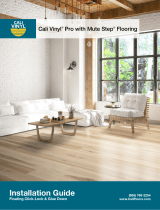 CALI 7904500800 Installation guide
CALI 7904500800 Installation guide
-
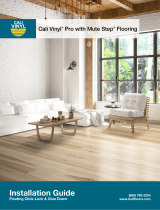 CALI 7904501200 Installation guide
CALI 7904501200 Installation guide
-
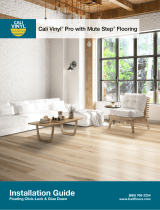 CALI 7904500800 Installation guide
CALI 7904500800 Installation guide
-
 CALI 7904108000 Installation guide
CALI 7904108000 Installation guide
-
 CALI 7902500400 Installation guide
CALI 7902500400 Installation guide
-
 CALI 7904108000 Installation guide
CALI 7904108000 Installation guide
-
 CALI 7902500600 Installation guide
CALI 7902500600 Installation guide
-
 CALI 7904108100 Installation guide
CALI 7904108100 Installation guide
Other documents
-
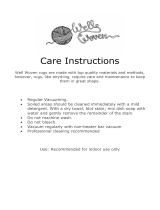 Well Woven MG-54-7 User manual
Well Woven MG-54-7 User manual
-
 Cinch 43385 Installation guide
Cinch 43385 Installation guide
-
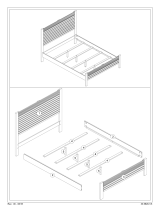 Artefama Furniture 5829.0001 Operating instructions
Artefama Furniture 5829.0001 Operating instructions
-
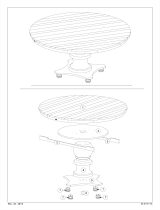 Artefama Furniture 6012.0001 Installation guide
Artefama Furniture 6012.0001 Installation guide
-
Pinnacle RVS1709 Installation guide
-
TrafficMASTER HP3413A Installation guide
-
Builders Choice C16010208X User manual
-
Cali Bamboo 7003001000 Installation guide
-
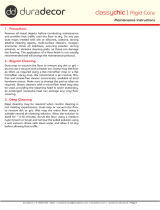 DuraDecor DD-CC-5HDT3458 User guide
DuraDecor DD-CC-5HDT3458 User guide
-
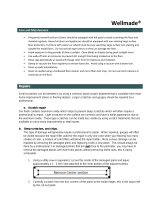 Islander HDPCEB8.5T-CAM User manual
Islander HDPCEB8.5T-CAM User manual

























